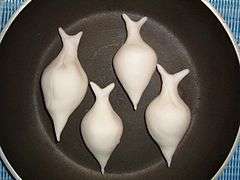Thinla (month)

Thinlā (Nepal Bhasa: थिंला) is the second month in the Nepal Era calendar, the national lunar calendar of Nepal.[1] The month corresponds to Margashirsha (मार्गशीर्ष) in the Hindu lunar calendar and roughly matches December in the Gregorian calendar.
Thinlā begins with the new moon and the full moon falls on the 15th of the lunar month. The month is divided into the bright and dark fortnights which are known as Thinlā Thwa (थिंला थ्व) and Thinlā Gā (थिंला गा) respectively.
The main event during this month is the Hindu festival of Vaikuntha Ekadashi which is dedicated to Vishnu. It falls on the 11th day of the bright fortnight. The full moon is also a major religious holiday. In Nepal Mandala, the day is celebrated as Yomari Punhi (यःमरि पुन्हि).[2] The festival celebrates the harvest. The special food of the day is a confection known as Yomari, a dumpling made of rice-flour dough filled with a paste of molasses and sesame seeds. In other cultures, the day is known as Dhānya Purnimā.[3]
Days in the month
| Thwa (थ्व) or Shukla Paksha (bright half) |
Gā (गा) or Krishna Paksha (dark half) |
|---|---|
| 1. Pāru | 1. Pāru |
| 2. Dwitiyā | 2. Dwitiyā |
| 3. Tritiyā | 3. Tritiyā |
| 4. Chauthi | 4. Chauthi |
| 5. Panchami | 5. Panchami |
| 6. Khasti | 6. Khasti |
| 7. Saptami | 7. Saptami |
| 8. Ashtami | 8. Ashtami |
| 9. Navami | 9. Navami |
| 10. Dashami | 10. Dashami |
| 11. Ekādashi | 11. Ekādashi |
| 12. Dwādashi | 12. Dwādashi |
| 13. Trayodashi | 13. Trayodashi |
| 14. Chaturdashi | 14. Charhe (चह्रे) |
| 15. Punhi (पुन्हि) | 15. Āmāi (आमाइ) |
Months of the year
| Devanagari script | Roman script | Corresponding Gregorian month | Name of Full Moon |
|---|---|---|---|
| 1. कछला | Kachhalā | November | Saki Milā Punhi, Kārtik Purnimā |
| 2. थिंला | Thinlā | December | Yomari Punhi, Dhānya Purnimā |
| 3. पोहेला | Pohelā | January | Milā Punhi, Paush Purnimā |
| 4. सिल्ला | Sillā | February | Si Punhi, Māghi Purnimā |
| 5. चिल्ला | Chillā | March | Holi Punhi, Phāgu Purnimā |
| 6. चौला | Chaulā | April | Lhuti Punhi, Bālāju Purnimā |
| 7. बछला | Bachhalā | May | Swānyā Punhi, Baisākh Purnimā |
| 8. तछला | Tachhalā | June | Jyā Punhi, Gaidu Purnimā |
| 9. दिल्ला | Dillā | July | Dillā Punhi, Guru Purnimā |
| 10. गुंला | Gunlā | August | Gun Punhi, Janāi Purnimā (Raksha Bandhan) |
| 11. ञला | Yanlā | September | Yenyā Punhi, Bhādra Purnimā |
| 12. कौला | Kaulā | October | Katin Punhi, Kojāgrat Purnimā |
References
- ↑ "Nepal Sambat gets national status". The Rising Nepal. 24 October 2008. Retrieved 8 May 2014.
- ↑ Makaju, Uttam (2014). ""Yomari Punhi": A South Asian Post-harvest Festival among Newars of Nepal". Canadian Newa Guthi. Retrieved 15 May 2014.
- ↑ Levy, Robert Isaac (1990). "A Catalogue of Annual Events and Their Distribution throughout the Lunar Year". Mesocosm: Hinduism and the Organization of a Traditional Newar City in Nepal. University of California Press. p. 644. ISBN 9780520069114.